Rebecca Mead in The New Yorker:
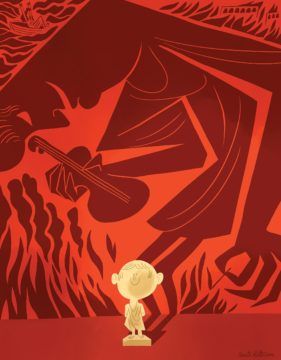 Nero, who was enthroned in Rome in 54 A.D., at the age of sixteen, and went on to rule for nearly a decade and a half, developed a reputation for tyranny, murderous cruelty, and decadence that has survived for nearly two thousand years. According to various Roman historians, he commissioned the assassination of Agrippina the Younger—his mother and sometime lover. He sought to poison her, then to have her crushed by a falling ceiling or drowned in a self-sinking boat, before ultimately having her murder disguised as a suicide. Nero was betrothed at eleven and married at fifteen, to his adoptive stepsister, Claudia Octavia, the daughter of the emperor Claudius. At the age of twenty-four, Nero divorced her, banished her, ordered her bound with her wrists slit, and had her suffocated in a steam bath. He received her decapitated head when it was delivered to his court. He also murdered his second wife, the noblewoman Poppaea Sabina, by kicking her in the belly while she was pregnant.
Nero, who was enthroned in Rome in 54 A.D., at the age of sixteen, and went on to rule for nearly a decade and a half, developed a reputation for tyranny, murderous cruelty, and decadence that has survived for nearly two thousand years. According to various Roman historians, he commissioned the assassination of Agrippina the Younger—his mother and sometime lover. He sought to poison her, then to have her crushed by a falling ceiling or drowned in a self-sinking boat, before ultimately having her murder disguised as a suicide. Nero was betrothed at eleven and married at fifteen, to his adoptive stepsister, Claudia Octavia, the daughter of the emperor Claudius. At the age of twenty-four, Nero divorced her, banished her, ordered her bound with her wrists slit, and had her suffocated in a steam bath. He received her decapitated head when it was delivered to his court. He also murdered his second wife, the noblewoman Poppaea Sabina, by kicking her in the belly while she was pregnant.
Nero’s profligacy went beyond slaughtering his nearest and dearest. He spent a fortune building an ornate palace, only to have it burn down, along with the rest of the city of Rome, in a conflagration that lasted for more than a week. Nero watched the destruction from a safe elevation, singing of the decimation of Troy. He was famous for never wearing the same garment twice. He sought out sexual thrills like a hog snuffling for truffles. He had a favored freedman, Sporus, castrated, then married him in a ceremony in which Sporus was dressed in the traditional garb of a bride and Nero played the groom. Later, Nero repeated the ceremony with another of his freedmen playing the groom while he adopted the role of bride, sans castration; the pseudo-nuptials were consummated on a couch in full view of guests at a banquet. He was attention-seeking, petulant, arbitrary. He had the senator Publius Clodius Thrasea Paetus murdered on the ground that his expressions were overly melancholic.
More here.
Mujib Mashal in The New York Times:
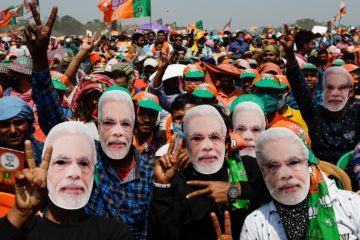 To become prime minister, Mr. Modi overcame a reputation tarnished by his alleged involvement in fanning religious violence when he was chief minister of the state of Gujarat two decades ago. For a time, he was banned from entering the United States on grounds that he had violated religious freedoms. He successfully rebranded himself as the Hindu nationalist who could be India’s development champion. Soon after winning election in 2014, he traveled to the New York and spoke for an hour in a packed Madison Square Garden to chants of “Modi! Modi! Modi!” In seven years as prime minister, he has tightly controlled his image. He prefers choreographed rallies and selective interviews over news conferences, avoiding vulnerability while offering plenty of content for his social media apparatus and network of celebrity supporters.
To become prime minister, Mr. Modi overcame a reputation tarnished by his alleged involvement in fanning religious violence when he was chief minister of the state of Gujarat two decades ago. For a time, he was banned from entering the United States on grounds that he had violated religious freedoms. He successfully rebranded himself as the Hindu nationalist who could be India’s development champion. Soon after winning election in 2014, he traveled to the New York and spoke for an hour in a packed Madison Square Garden to chants of “Modi! Modi! Modi!” In seven years as prime minister, he has tightly controlled his image. He prefers choreographed rallies and selective interviews over news conferences, avoiding vulnerability while offering plenty of content for his social media apparatus and network of celebrity supporters.
In the face of crisis, Mr. Modi has displayed a talent of inventing a new narrative and switching personas, including combative national champion, digital leader and spiritual guide. At times he could seem deeply relatable, at others above it all. And he had what the opposition lacked: an ability to take his message viral.
During the 2019 election, with the economy weakening, he emphasized the threat from Pakistan. Referring to an earlier comment Mr. Modi had made, his party projected him as the nation’s toughest “watchman,” boasting about the size of Mr. Modi’s chest as a sign of his strength.
Just before the voting, he visited a temple and went to meditate in a cave, emphasizing his religious devotion. The path was covered by a red carpet and surrounded by cameras. There were even photos and footage of the meditating Mr. Modi inside the small cave. After last year’s first wave of the virus, Mr. Modi declared victory, saying India “with a proactive approach” had saved “the entire humanity from a big tragedy.” He transitioned to an image of a wise man at the service of the nation. He grew his beard. His office posted a video of Mr. Modi feeding baby peacocks, strolling with full-plumage adult birds and perusing documents with one at his feet.
More here.
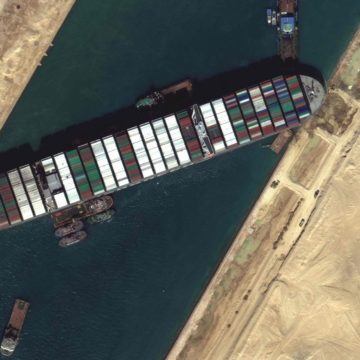 Mona Ali in Phenomenal World:
Mona Ali in Phenomenal World:
Why did the Ever Given capture our collective imaginations? At the tail end of its moment in the spotlight, the poet Kamran Javadizadeh tweeted: “I too am ‘partially refloated,’ I too remain stuck in the Suez Canal.” Two fluorescent yellow-vested construction workers with an excavator—lego-like compared to the gargantuan hulk of the vessel—attempted to wrench the giant ship from the sand bank. Dredgers and tugboats aided by rising tides finally refloated the massive freighter, launching it back on its voyage from Yantian to Rotterdam.
While the immediate cause of the ship’s running aground may have been a sandstorm blowing in from the Sahara, the vessel’s size—it is one of the world’s largest container ships—was a decisive factor. Its stymied trip seemed symbolic of the shorted circuits of supply chains in the year of the pandemic. And, like the products it carries, the ship is a transnational project: Japanese-owned; Taiwanese-leased; German-managed; an Indian crew; its Panamanian flag indicating the ship’s registry in that offshore haven which grants asset-owners tax exemptions and enables the employment of cheaper foreign labor. This whale of a ship beached by the khamsin—seasonal windstorms (the ‘winds of God’) that can wreak havoc for fifty days and nights—temporarily blocked the liquid arteries of global trade.
The Suez is a man-made strait through which more than 12 percent of world trade and 10 percent of crude oil flows. On any given day, its waters carry one-third of global container ship traffic. A short-cut to Europe, the canal is a conduit in the contemporary maritime silk road that ribbons across the South China Sea, through the Malacca Straits to the Bay of Bengal and the Arabian Sea into the Gulf of Aden. From its southerly entrance in the Red Sea, the Suez laboriously winds into the Mediterranean, channeling iPhones and Pelotons towards the Global North.
More here.
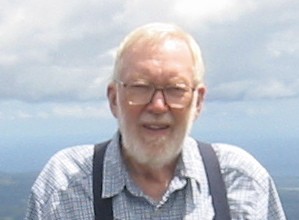 Leo Robson in the NLR’s Sidecar:
Leo Robson in the NLR’s Sidecar:
The death of J. Hillis Miller, in February, marked the end of an astonishing period in American academic literary criticism – North American really, since the dominant figure, Northrop Frye, was born in Québec and taught in Toronto. The period might be said to start in 1947, with the publication of Frye’s first book, the Blake study Fearful Symmetry, and yielded a body of work drawing on the kind of Continental resources – Marxism and psychoanalysis but also theology, linguistics, hermeneutics, and mythopoetics – that had been accorded little place by earlier formalist approaches. Miller, the author of twenty-five books, was rare among the central figures in devoting his attention to study of the novel, from Emily Brontë to Ian McEwan. The arc of Miller’s career has been described by Fredric Jameson as ‘unclassifiable’, but in bald terms, it was the story of a pair of Francophone mentors, Georges Poulet and Jacques Derrida, who washed up in Baltimore – more specifically, the campus of Johns Hopkins, where Miller taught from 1952 until 1972. Miller welcomed their interventions and ran with them, transforming himself into a leading exponent of two critical schools, one – phenomenology – that remains more or less pegged to its post-war moment, the other – deconstruction – with wider fame and implications, and a more contested legacy.
He was born in Virginia, in 1928, and raised in upstate New York – ‘definitely the boondocks’, he recalled. His mother was descended from Pennsylvania Dutch; one of her ancestors, a Rhode Islander, had been a signatory on the Declaration of Independence. Miller’s father, himself the son of a farmer, was a Baptist minister as well as a professor and an academic administrator who emphasised women’s higher education. But Miller’s upbringing wasn’t especially urbane.
More here.
So a new similitude is given us
And we say, The soul may be compared
Unto a spoonbait that a child discovers
Beneath the sliding lid of a pencil case,
Glimpsed once and imagined for a lifetime
Risen and free and spooling out of nowhere —
A shooting star going back up the darkness.
It flees him and burns him all at once.
Like the single drop that Dives implored
Falling and falling into a great gulf.
Then exit, the polished helmet of a hero
Laid out amidships above the scudding water.
Exit, alternatively, a toy of light
Reeled through him upstream, snagging on nothing.
by Seamus Heaney
from The Haw Lantern
Farrar Straus Giroux, 1987
Tarun Timalsina at the Harvard Political Review:
Harvard Political Review: You have called effective altruism, and I quote, one of the great new ideas of the 21st century. Could you briefly introduce our readers to the core philosophy of the effective altruism movement and explain why you think the movement can be a big deal?
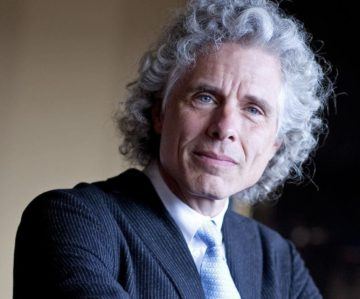 Steven Pinker: The idea behind effective altruism is to channel charitable giving and other philanthropic activities to where they will do the most good, where they would lead to the greatest increase in human flourishing. And the reason that it’s needed is that we are all altruistic. It is part of human nature. On the other hand, we have a large set of motives for why we’re altruistic and some of them are ulterior — such as appearing beneficent and generous, or earning friends and cooperation partners. Some of them may result in conspicuous sacrifices that indicate that we are generous and trustworthy people to our peers but don’t necessarily do anyone any good. And so the idea behind effective altruism is to determine where your activities actually save lives, increase health, reduce poverty, and at the very least provide people opportunities to channel their philanthropy where it will do the most good. And, of course, also to encourage people to do that. So part of it is just informing people if that is their goal and telling them that these are the ways to do it. And the other is to spread the value that that’s where philanthropy ought to be directed.
Steven Pinker: The idea behind effective altruism is to channel charitable giving and other philanthropic activities to where they will do the most good, where they would lead to the greatest increase in human flourishing. And the reason that it’s needed is that we are all altruistic. It is part of human nature. On the other hand, we have a large set of motives for why we’re altruistic and some of them are ulterior — such as appearing beneficent and generous, or earning friends and cooperation partners. Some of them may result in conspicuous sacrifices that indicate that we are generous and trustworthy people to our peers but don’t necessarily do anyone any good. And so the idea behind effective altruism is to determine where your activities actually save lives, increase health, reduce poverty, and at the very least provide people opportunities to channel their philanthropy where it will do the most good. And, of course, also to encourage people to do that. So part of it is just informing people if that is their goal and telling them that these are the ways to do it. And the other is to spread the value that that’s where philanthropy ought to be directed.
More here.
Alvin Powell in The Harvard Gazette:
GAZETTE: There’s been a lot written about psychedelics in recent years. How did the center get started?
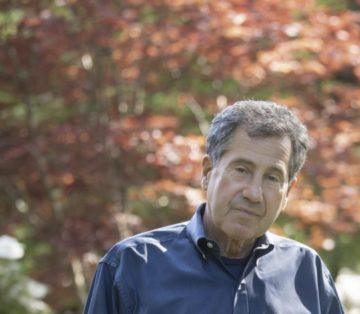 ROSENBAUM: In retrospective, it appears inadvertent. I spent a little less than 20 years as chief of psychiatry at Mass General and toward the end of that term, I was talking to a patient about his suffering, his torment, what was really bothering him. He was very vivid, and I had this “aha” moment. Much of the burden of all the different conditions that we treat in psychiatry, whether it’s OCD, anxiety disorders, addiction, depression, a main source of suffering is a kind of repetitive, stuck, painful dwelling on things: rumination. I made a practice of asking every one of my patients about rumination and found that it was a substantial part of their suffering. I realized that as a field we had not paid sufficient attention to it.
ROSENBAUM: In retrospective, it appears inadvertent. I spent a little less than 20 years as chief of psychiatry at Mass General and toward the end of that term, I was talking to a patient about his suffering, his torment, what was really bothering him. He was very vivid, and I had this “aha” moment. Much of the burden of all the different conditions that we treat in psychiatry, whether it’s OCD, anxiety disorders, addiction, depression, a main source of suffering is a kind of repetitive, stuck, painful dwelling on things: rumination. I made a practice of asking every one of my patients about rumination and found that it was a substantial part of their suffering. I realized that as a field we had not paid sufficient attention to it.
I have a friend who is a passionate advocate for decriminalization and the development of psychedelics as therapeutics. There was a conference on psychedelics at the Broad Institute and he asked me to attend.
More here.
Mark Blyth in The Guardian:
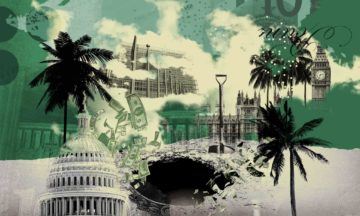 In the early 90s, governments started buying into an argument about capital mobility, taxes and welfare states: in a world of global capital, investors will seek the best returns they can get globally. If those returns are reduced by “distortions” such as taxes, investment will flow to countries that tax less. Consequently, those expensive and expansive welfare states that neoliberal economists had always targeted had to go. Funding them through taxing the wealthy and corporations would lower investment and employment, so the story went.
In the early 90s, governments started buying into an argument about capital mobility, taxes and welfare states: in a world of global capital, investors will seek the best returns they can get globally. If those returns are reduced by “distortions” such as taxes, investment will flow to countries that tax less. Consequently, those expensive and expansive welfare states that neoliberal economists had always targeted had to go. Funding them through taxing the wealthy and corporations would lower investment and employment, so the story went.
Governments across the Organisation for Economic Co-ordination and Development (OECD) used this argument to cut taxes on both individuals and corporations. The UK’s corporate tax rate fell from 34% to 19% between 1990 and 2019, while the US’s rates fell from 35% to 21% over the same period. But rather than those reductions leading to an explosion of investment in both countries, investment levels actually fell, as the tax-savings made were taken as profit and pushed into asset markets. In the UK, gross fixed-capital investment fell from 23.5% of GDP in 1990 to 17% in 2019. In the US, it fell from 23.5% to 19%.
While utterly failing to promote investment, what such changes did set up was ruinous tax competition between states.
More here.
Justin St. Clair at the LARB:
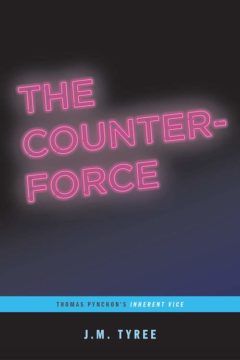 Tyree’s answer to our present dilemma is weirdness, “cultivated eccentricity as an antidote to a world gone mad.” He proposes a Pynchonian counterforce, a ragged band of outsiders and misfits to resist all the orthodoxies of the day. Despite the polarization of the moment, both the left and the right feverishly engage in what Tyree terms timewashing: “[O]ur era’s signature creation of fake pasts that purport to cleanse history of its deep stains and recurring nightmares with the scented spray of propaganda.” Our “incapacity to live with the past in all its troubling complexity” poses a grave danger, he argues, and better fiction could be our salvation. He’s right, of course, but he also knows the unlikelihood of his solution: “Is it naïve to assert that we badly need dreamers like Pynchon to help us imagine a different future by reading through a different lens on our past?” Tyree answers his own question just three sentences later: “Yeah, that’s probably naïve.”
Tyree’s answer to our present dilemma is weirdness, “cultivated eccentricity as an antidote to a world gone mad.” He proposes a Pynchonian counterforce, a ragged band of outsiders and misfits to resist all the orthodoxies of the day. Despite the polarization of the moment, both the left and the right feverishly engage in what Tyree terms timewashing: “[O]ur era’s signature creation of fake pasts that purport to cleanse history of its deep stains and recurring nightmares with the scented spray of propaganda.” Our “incapacity to live with the past in all its troubling complexity” poses a grave danger, he argues, and better fiction could be our salvation. He’s right, of course, but he also knows the unlikelihood of his solution: “Is it naïve to assert that we badly need dreamers like Pynchon to help us imagine a different future by reading through a different lens on our past?” Tyree answers his own question just three sentences later: “Yeah, that’s probably naïve.”
more here.
Ah son, do you know, do you know
where you come from?
From a lake with white
and hungry gulls.
Next to the water of winter
she and I raised
a red bonfire
wearing out our lips
from kissing each other’s souls,
casting all into the fire,
burning our lives.
That’s how you came into the world.
But she, to see me
and to see you, one day
crossed the seas
and I, to clasp, her tiny waist,
walked all the earth,
with wars and mountains,
with sands and thorns.
That’s how you came into the world.
You come from so many places,
from the water and the earth,
from the fire and the snow,
from so far away you journey
toward the two of us,
from the terrible love
that has enchained us,
that we want to know
what you’re like what you say to us
because you know more
about the world we gave you.
Like a great storm
we shook
the tree of life
down to the hiddenmost
fibers of the roots
and you appear now
singing in the foliage,
in the highest branch
that with you we reach
by Pablo Neruda
from The Captain’s Verses
New Directions Books, 1972
Translation: Donald D. Walsh
Original Spanish at “Read More”
Adam Kirsch in The New Yorker:
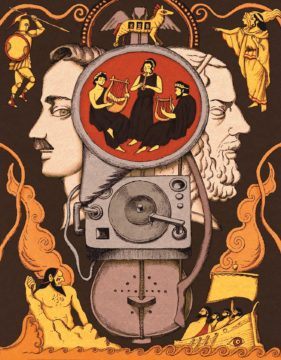 The Western tradition has never been more appealingly portrayed than in Rembrandt’s 1653 painting “Aristotle with a Bust of Homer.” Whether you stand in front of it at the Metropolitan Museum or look at it online, the painting turns you into a link in a chain that goes back three thousand years. Here you are in the twenty-first century, contemplating a painting made in Amsterdam in the seventeenth century, which portrays a philosopher who lived in Athens in the fourth century B.C., looking at a poet thought to have lived in the eighth century B.C. Tradition abolishes time, making us all contemporaries. Yet the painting hints that Homer doesn’t quite belong in the same dimension of reality occupied by you, Aristotle, and Rembrandt.
The Western tradition has never been more appealingly portrayed than in Rembrandt’s 1653 painting “Aristotle with a Bust of Homer.” Whether you stand in front of it at the Metropolitan Museum or look at it online, the painting turns you into a link in a chain that goes back three thousand years. Here you are in the twenty-first century, contemplating a painting made in Amsterdam in the seventeenth century, which portrays a philosopher who lived in Athens in the fourth century B.C., looking at a poet thought to have lived in the eighth century B.C. Tradition abolishes time, making us all contemporaries. Yet the painting hints that Homer doesn’t quite belong in the same dimension of reality occupied by you, Aristotle, and Rembrandt.
Aristotle is portrayed realistically in the dress of Rembrandt’s time—sumptuous white shirt, simple black apron, and broad-brimmed hat. (It wasn’t until the twentieth century that art historians determined that the figure was Aristotle; earlier identifications included a contemporary of Rembrandt’s, the writer Pieter Cornelisz Hooft.) In other words, Aristotle is a human being like us, albeit an extraordinary one. Homer, however, is a white marble bust—a work of art within a work of art.
It’s a reminder that, even for Aristotle, Homer was more a legend than a man. In his Poetics, the philosopher credits the poet with inventing epic, drama, and comedy. “It is Homer who has chiefly taught other poets the art of telling lies skillfully,” he writes with evident ambivalence. Herodotus, known as the first historian, saw Homer, along with the poet Hesiod, as having invented Greek mythology, calling them the first to “give the gods their epithets, to allot them their several offices and occupations, and describe their forms.” When it comes to things like when and where Homer lived, however, the earliest sources are already unreliable. According to tradition, the poet was blind and was born on the island of Chios, where a guild of rhapsodes—reciters of epic poetry—later became known as the Homeridae, “children of Homer,” and claimed to be his direct descendants. But there is no evidence for any of these assertions, and some ancient biographies of Homer are obviously fanciful.
Herodotus writes that Homer lived “four hundred years before my time,” which would put him in the ninth century B.C., but adds that this is “my own opinion,” with no real proof behind it.
More here.
From Phys.Org:
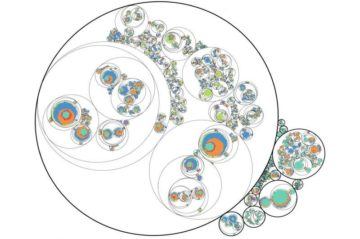 It’s often cancer’s spread, not the original tumor, that poses the disease’s most deadly risk. “And yet metastasis is one of the most poorly understood aspects of cancer biology,” says Kamen Simeonov, an M.D.-Ph.D. student at the University of Pennsylvania Perelman School of Medicine.
It’s often cancer’s spread, not the original tumor, that poses the disease’s most deadly risk. “And yet metastasis is one of the most poorly understood aspects of cancer biology,” says Kamen Simeonov, an M.D.-Ph.D. student at the University of Pennsylvania Perelman School of Medicine.
In a new study, a team led by Simeonov and School of Veterinary Medicine professor Christopher Lengner has made strides toward deepening that understanding by tracking the development of metastatic cells. Their work used a mouse model of pancreatic cancer and cutting-edge techniques to trace the lineage and gene expression patterns of individual cancer cells. They found a spectrum of aggression in the cells that arose, with cells that were likely to remain in place at the primary tumor at one end and those that were more likely to move to new sites and colonize other tissues at the other end.
Of the cells that eventually became metastatic and grew in tissues and organs beyond the pancreas, the majority shared a common lineage, the researchers discovered. “By building a precision tool for probing cancer metastasis in vivo, we’re able to observe previously inaccessible types of information,” says Simeonov. “We were able to use this lineage tracing approach to rank cells based on how metastatic they were and then relate these differences in behavior to gene expression changes.” The group’s findings, published in the journal Cancer Cell, suggest that it’s not only genetic mutations that can drive cancer’s spread; the single-cell RNA profiling results underscore that gene expression patterns—which genes cells are turning on and off—play a key role in disease outcomes.
More here.

Dear Reader,
Here’s your chance to say what you want to the large number of highly educated readers that make up 3QD’s international audience. Several of our regular columnists have had to cut back or even completely quit their columns for 3QD because of other personal and professional commitments and so we are looking for a few new voices. We do not pay, but it is a good chance to draw attention to subjects you are interested in, and to get feedback from us and from our readers.
We would certainly love for our pool of writers to reflect the diversity of our readers in every way, including gender, age, ethnicity, race, sexual orientation, etc., and we encourage people of all kinds to apply. And we like unusual voices and varied viewpoints. So please send us something. What have you got to lose? Click on “Read more” below…
Stephen Law in Psyche:
 These squiggles have a meaning. So do spoken words, road signs, mathematical equations and signal flags. Meaning is something with which we’re intimately familiar – so familiar that, for the most part, we barely register or think about it at all. And yet, once we do begin to reflect on meaning, it can quickly begin to seem bizarre and even magical. How can a few marks on a sheet of paper reach out across time to refer to a person long dead? How can a mere sound in the air instantaneously pick out a galaxy light-years away? What gives words these extraordinary powers? The answer, of course, is that we do. But how?
These squiggles have a meaning. So do spoken words, road signs, mathematical equations and signal flags. Meaning is something with which we’re intimately familiar – so familiar that, for the most part, we barely register or think about it at all. And yet, once we do begin to reflect on meaning, it can quickly begin to seem bizarre and even magical. How can a few marks on a sheet of paper reach out across time to refer to a person long dead? How can a mere sound in the air instantaneously pick out a galaxy light-years away? What gives words these extraordinary powers? The answer, of course, is that we do. But how?
A slogan often associated with the later philosophy of Ludwig Wittgenstein (1889-1951) is ‘meaning is use’. Here’s what Wittgenstein actually says:
For a large class of cases of the employment of the word ‘meaning’ – though not for all – this word can be explained in this way: the meaning of a word is its use in the language.
In order to appreciate the philosophical significance of this remark, let’s begin by looking at one of the key things that Wittgenstein is warning us against.
Suppose I say: ‘It’s hot today.’ So does a parrot. Saying the words is a process; for example, it can be done quickly or slowly.
However, unlike the parrot, I don’t just say something: I mean something. This might suggest that, when it comes to my use of language, two processes take place. But where does this second process – that of meaning something – occur?
More here.
James Dinneen and Alexander Kennedy in Undark:
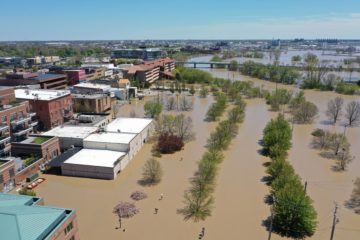 While the dramatic breach of the Edenville Dam captured national headlines, an Undark investigation has identified 81 other dams in 24 states, that, if they were to fail, could flood a major toxic waste site and potentially spread contaminated material into surrounding communities.
While the dramatic breach of the Edenville Dam captured national headlines, an Undark investigation has identified 81 other dams in 24 states, that, if they were to fail, could flood a major toxic waste site and potentially spread contaminated material into surrounding communities.
In interviews with dam safety, environmental, and emergency officials, Undark also found that, as in Michigan, the risks these dams pose to toxic waste sites are largely unrecognized by any agency, leaving communities across the country vulnerable to the same kind of low-probability, but high-consequence disaster that played out in Midland.
More here.
Raghuram G. Rajan in Project Syndicate:
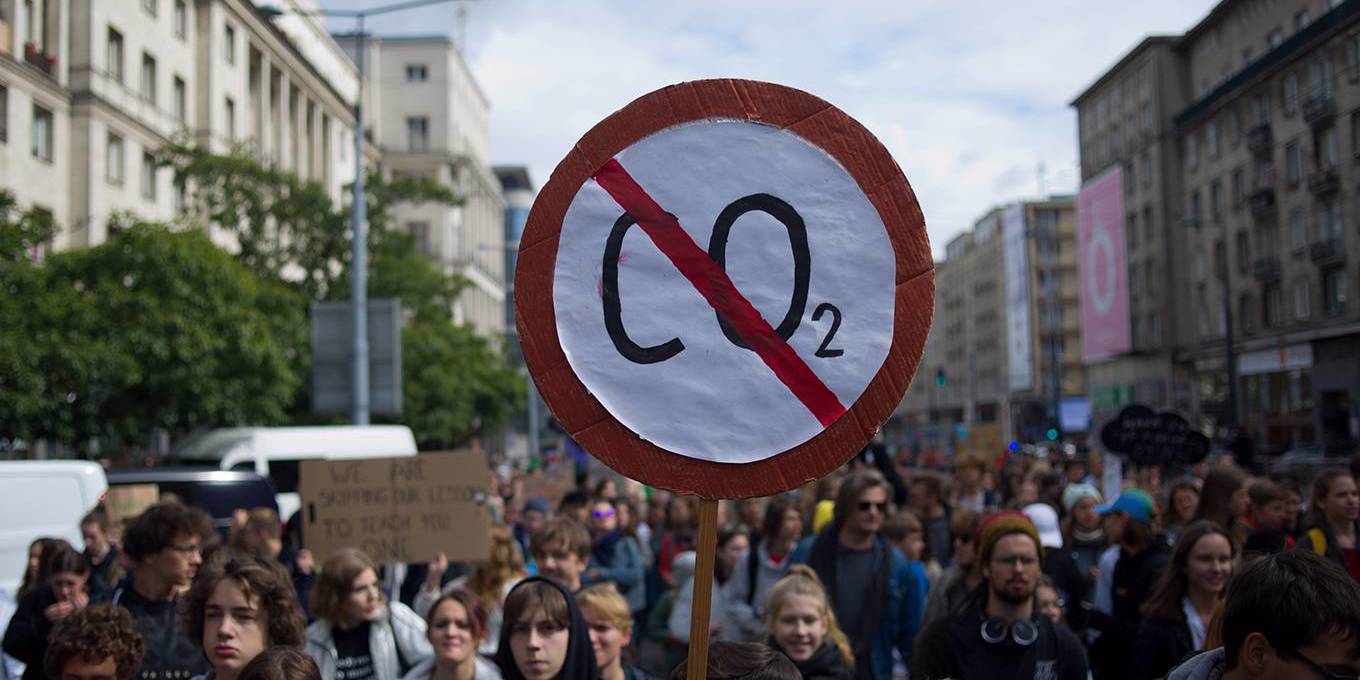
Economists generally agree that the way to reduce GHG emissions is to tax them. But such taxes almost certainly will cause disruptive economic changes in the short run, which is why discussions of imposing them tend to run quickly into free-rider or fairness problems.
For example, industrialized countries such as the US are concerned that while they work hard to reduce emissions, developing countries will keep pumping them out with abandon. But at the same time, developing countries like Uganda point out that there is profound inequity in asking a country that emitted just 0.13 tons of carbon dioxide per capita in 2017 to bear the same burden as the US or Saudi Arabia, with their respective per capita emissions of 16 and 17.5 tons.
The least costly way to reduce global emissions would be to give every country similar incentives. While India should not keep building more dirty coal plants as it grows, Europe should be closing down the plants it already has. But each country will want to reduce emissions in its own way – some through taxation, others through regulation. The question, then, is how to balance national-level priorities with global needs so that we can save the one world we have.
More here.